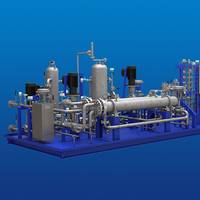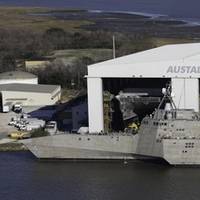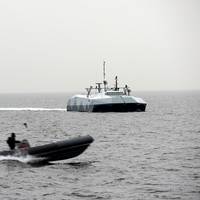Alfa Laval to Provide Fuel Supply System for Six Methanol-fueled Containerships

Alfa Laval said its FCM Methanol will be the low-flashpoint fuel supply system (LFSS) on six 1170 TEU containerships ordered by Eastaway, a member of the X-Press Feeders Group. The new vessel series, to be built at Chinese shipyards Ningbo Xinle Shipbuilding Group Co., Ltd and New Dayang Shipbuilding Co., Ltd, will have two-stroke MAN B&W ME-LGIM engines that can run on methanol as well as conventional fuels. The FCM Methanol deliveries will begin in June 2023.Peter Nielsen, President…
Cruise Ships Emits More Pollution into Europe
Carnival Corporation, the world’s largest luxury cruise operator, emitted nearly 10 times more sulphur oxide (SOX) around European coasts than did all 260 million European cars in 2017, said Transport & Environment.Royal Caribbean Cruises, the world’s second largest, is second, yet four times worse than the European car fleet, revealed a new analysis by sustainable transport group.SOX emissions form sulphate (SO4) aerosols that increase human health risks and contribute to acidification in terrestrial and aquatic environments.In absolute terms, Spain, Italy and Greece, closely followed by France and Norway, are the European countries most exposed to SOX air pollution from cruise vessels while Barcelona…
EU Transport Commissioner Violeta Bulc Launches Network for Drone Demonstration
EU Transport Commissioner Violeta Bulc launched the European network for drone demonstration projects. The network will become a forum to share knowledge on how to keep drone operations safe, secure and green.According to press release, it will focus on the so-called U-space: a system that connects all drones flying in the air and that makes all drones visible for authorities and citizens.Commissioner for Transport Violeta Bulc said: "Drones are a key part of the future of aviation and will become part of our daily lives. All players can mutually learn and exchange practical expertise to keep drone operations safe, secure and clean.
DNV GL Seeks to Standardize Floating Turbines
DNV GL launched a new joint industry project (JIP) together with thirteen global partners to mutually develop a Recommended Practice for the coupled analysis of floating offshore wind turbines. Despite the fact that the wind industry has a strong focus on the development of floating offshore wind turbines, it is still missing a widely recognised and unified approach for the practical methods to build and validate the numerical models, in accordance with the requirements in the standards. Standardisation is a key milestone to guide the industry towards the development of reliable floating wind turbines. Guidance includes setting up minimum requirements for the design on new concepts that can help investors’ evaluation…
US Military Program Targets Transitioning Technologies
The U.S. Department of Defense (DoD) issued a Broad Agency Announcement (BAA) on May 28, 2014 seeking proposals under the Rapid Innovation Fund (RIF) program to transition innovative technologies that resolve operational challenges or save costs into existing acquisition programs. The RIF Program is a Congressionally-mandated program, currently authorized from FY11 – FY15 and managed by the Office of the Secretary of Defense (OSD). RIF facilitates innovative technologies that show a clear transition path to fielding the technology into existing defense acquisition programs. There is a two-step selection process. The BAA will list the technology areas of interest for each participating component, instructions for submission of white papers, and source selection criteria.
Unmanned Navy Carrier Aircraft Program: Progress Update
One year ago, Sailors watched an unmanned air vehicle take-off from a nuclear-powered carrier flight deck for the first time in naval aviation history, says Capt. "May 14, 2013 was an extraordinary day for the Navy. The crew from USS George H.W. Bush launched the X-47B that morning off the coast of Virginia. The tailless, autonomous unmanned aircraft took to the skies, while the flight crew on deck celebrated this historic achievement. Our Naval Air Forces Commander Vice Adm. David Buss called it “a watershed event” as he watched from the flight deck. He compared this event to aviation pioneer Eugene Ely’s first-ever landing on the deck of a ship in 1911. In July, the UCAS-D team went back to the ship and took testing one step further.
U.S. Navy awards contracts to Lockheed, Austal for 4 more ships

The U.S. Navy has awarded contracts worth nearly $1.4 billion to buy four more Littoral Combat Ships from Lockheed Martin Corp and Australia's Austal Ltd, the U.S. Defense Department said on Monday. Lockheed won a contract valued at $699 million to build two more of its steel monohull-design ships, while Austal won a contract worth $684 million to build two more of its aluminum trimaran design, the Pentagon said in its daily digest of major weapons contracts. Lockheed welcomed the contract…
Port of Pittsburgh Seeks Technology Testers
The Port of Pittsburgh Commission seeks local companies and individuals to participate in its Wireless Waterway (WW) Interoperability Test Bed (ITB) the week of June 15, 2014. The commission is accepting applications through April 1, 2014 from interested entrepreneurs, organizations and vendors to conduct demonstrations of technologies and products on the WWITB. In addition it seeks volunteers both to act as professional evaluators and to assist in the operations of the event. The commission established this test bed to help identify technologies which addressed critical river water challenges in the areas of river transportation, communications, environment, safety, sensor, communications, cyber-security, collaboration and interoperability.
Stiletto Maritime Demonstration Program hosts Capability Demonstration
The Stiletto Maritime Demonstration Program conducted its first Capability Demonstration, Jan. 14-27. The initial demonstration was hosted for the Navy Expeditionary Combat Command (NECC) off the Virginia coast near the Joint Expeditionary Base Little Creek, Fort Story in Virginia Beach, Va. The Capability Demonstration provided NECC Sailors an opportunity to observe new technologies developed by industry in a realistic military maritime environment. The program also provided the 15 participating industry partners an opportunity to receive immediate end-user feedback toward increasing technology readiness levels. “Warfighting needs are rapidly changing…
Stiletto Craft Trials Assessed by NECC

The Stiletto Maritime Demonstration Program has conducted its first capability demonstration for the Navy Expeditionary Combat Command (NECC). The Stiletto is a unique, maritime demonstration craft developed by the Defense Department to test littoral warfare concepts. Engineers and technicians with specialized expertise in maritime technology from Naval Surface Warfare Center (NSWC) Carderock's Norfolk detachment maintain and operate the 88-foot-long, composite-bodied, m-shaped vessel.
Rutter Acquires OceanWaveS GmbH
Acquisition combines leaders in marine radar signal processing. Rutter Inc. (TSX: RUT) is pleased to announce it has acquired OceanWaveS GmbH of Lüneburg, Germany, a recognized industry leader in the development and supply of radar-based wave and surface current measurement technology. Rutter’s sigma S6 and OceanWaveS’ WaMoS are respected within the industry for discrimination of ice, oil, small targets, waves, currents and bathymetry from conventional navigational X-band radar. Combining OceanWaveS’ wave and current measuring capabilities with Rutter’s sigma S6 Ice Navigator will give Rutter a competitive edge in a growing offshore and coastal monitoring market.
GE Provides LM2500 Gas Turbine Modules for U.S. Navy
GE Marine reports that its LM2500 aeroderivative marine gas turbines will be used to power the United States Navy’s new Flight IIA Arleigh Burke-class destroyers. GE has received orders for the initial three of an expected nine new Flight IIA ships. The new destroyers are being built as part of the U.S. Navy’s DDG 51 program. “The successful DDG 51 program already includes 57 destroyers delivered, with five additional ships under construction, all powered by GE LM2500 gas turbines. The U.S. Navy has been pleased with the performance and reliability of our engines on the Arleigh Burke class ships, as well as on the Ticonderoga class cruisers and Perry class frigates. Mean time between removal of the LM2500 gas turbines is roughly 23,000 hours, which equates to about 17 years in service.






